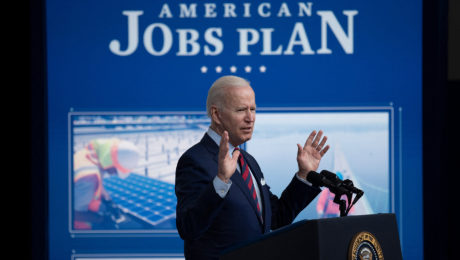Biden’s American Jobs Plan Could Be Monumental for the Care Economy in the U.S.
Last month, the Biden administration revealed the details of the $2 trillion American Jobs Plan.
The plan recognizes that investing in the care economy, as with investments in traditional infrastructure, can lift incomes, unleash productivity, and pave the path towards a more equitable economic recovery and growth.
Addressing the care crisis
Built into the plan is a pledge to “solidify the infrastructure of our care economy by creating jobs and raising wages and benefits for essential home care workers.” The plan calls for Congress to invest $400 billion towards expanding access to quality, affordable home- or community-based care for aging relatives and people with disabilities. These investments will help Americans to obtain the long-term services and support they need, while creating new jobs and offering care workers a long-overdue raise, stronger benefits, and an opportunity to organize or join a union and collectively bargain. Research has shown that increasing the pay of care workers leads to better quality care overall. Through creating well-paying care jobs with benefits and o collectively bargaining rights, as well as building state infrastructure, the plan aims to improve both the quality of job for care workers and the quality of service for care recipients.
Lack of access to childcare makes it harder for parents, especially mothers, to fully participate in the workforce, hurting families and hindering U.S. growth and competitiveness. In areas with the greatest shortage of child care slots, women’s labor force participation is about three percentage points less than in areas with a high capacity of child care slots. The pandemic has severely exacerbated this problem with more than 1 in 4 facilities still remaining closed as of December 2020. President Biden is calling on Congress to provide $25 billion to help upgrade child care facilities and increase the supply of child care in areas that need it most. These funds are to be provided through a Child Care Growth and Innovation Fund for states to build a supply of infant and toddler care in high-need areas. Also included in this $25 billion is a call for expanded tax credits to incentivize businesses to provide care facilities at their establishments. This will grant accessible, high quality care and learning environments for children of employees. This particular part of the plan is structured so that employers will receive 50 percent of the first $1 million of construction costs per facility.
Investment in care is investment in infrastructure
As Cecelia Rouse, Chair of the Economic Advisors for the Biden administration, recently indicated during a recent press conference, we need to “upgrade our definition of infrastructure” to include the care economy. Rouse defended the Biden administration’s plan to spend $400 billion of the infrastructure plan’s budget on the care economy, defining it as a legitimate infrastructure investment and a key component to addressing economic inequities in the U.S. The care economy is critical to U.S. economic activity, and its absence would greatly hinder economic productivity. The inclusion of care work and the care economy in the American Jobs Plan is a critical first step in mending a critically broken care infrastructure in the U.S.
Still, it is only the first step. The U.S. is the only industrialized nation that fails to provide national paid family leave and medical leave programs, and where hundreds of thousand sit on waiting lists for desperately needed home care. LeadingAge, which represents service providers in the sector, estimates that half of all Americans will need long-term services and support after turning 65, and that by 2040, a quarter of the U.S. population will be 65 or older. In addition to the President’s proposal for the care economy, we also need investments to finally put America on a path to universal childcare and early learning, national paid family and medical leave and paid sick days for all workers. The COVID-19 pandemic has exposed both the importance of care work and the vulnerabilities of our care infrastructure. At the same time, it has also created an opportunity for us to rethink the value of care and care work, opening ways for us to rebuild a more resilient care infrastructure and a more inclusive economy.
This blog was authored by Jenn Brown, CWE-GAM Communications Assistant
- Published in Child Care, Economic Recovery, Policy, U.S.
Making the Biden-Harris Economic Recovery Plan Gender Responsive
A recent Gender & COVID-19 brief (also a sign on letter) “Making the Biden-Harris Transition Plan for COVID-19 gender-responsive” outlines how the Biden-Harris Transition Plan in the US can be made more gender-responsive. The brief is a starting point in highlighting the potential within the Biden-Harris Transition Plan, using economic recovery as an entry point, with recommendations based on the best practices for feminist economic recovery from COVID-19.
The Biden-Harris Economic Recovery Plan is constructed around four challenges which must be overcome to rebuild the nation. The brief applies a gender lens for each challenge, emphasizing that for these efforts to be truly equitable, it is critical that they are not implemented in isolation and an intersectional gender lens is used in policy making and interventions.
- Mobilize American manufacturing and innovation to ensure that the future is made in America, and in all of America: Targeted support to business owners from under-represented groups in the forms of emergency funds, skills, training and mentorship; and direct funding to businesses in women-majority sectors, including caregiving and social enterprises, should be a centerpiece of the policy.
- Mobilize American Ingenuity to build a modern infrastructure and an equitable, clean equitable future: Investment in care infrastructure is also green, as it supports jobs for women (in the care sector) and men (in the construction sector), and provides services communities need to thrive. Implementing stimulus programs focused on ‘green jobs’ should proactively plan for gender equity and include formal programming for women, with special emphasis on displaced workers, communities of color, and women who are in recovery from incarceration.
- Mobilizing American talent and heart to build a 21st century caregiving and education workforce: Prioritize universally accessible, free (or highly subsidized) childcare and long-term elder care as central to its economic recovery plan. This can in part be accomplished through the designation of direct public funds to existing regulated and licensed care services. Direct public funds should also be used to invest in measures to keep workers safe and expand the number of care spaces available. Importantly, many workers who provide the backbone of the care economy are informally employed, wherein they have limited or no access to social protection. As such, government assistance schemes should be expanded to include family and informal caregivers, and an expedited path to permanent resident status should be created for precarious immigrant care workers so that they can access those schemes. This has a much greater effect than simply creating employment in the care sector but facilitates women’s participation across the economy.
- Mobilize across the board to advance racial equity in America: There can be no gender justice while there is racial injustice. Racial and gender inequities are inextricably linked to the economy. For example, Black, racialized, and immigrant women are disproportionately represented as personal support workers, cleaners, and in other essential but low-paid occupations – many of which are in the informal economy – that do not provide paid sick leave or family leave.
READ FULL BRIEF: Solomon A, Morgan R, Wenham C, Smith J, Nacif Pimenta D, Mueller V, Herten-Crabb A and Hawkins K (2020) Making the Biden-Harris Transition Plan for COVID-19 gender-responsive, Gender and COVID-19 project
This blog was authored by Jenn Brown, CWE-GAM Communications Assistant
Biden’s Care Plan Has the Potential to Change Care Work in the U.S. for the Better
Joe Biden has officially accepted the Democratic Presidential nomination, and he and his team plan to make substantial investments in the infrastructure of care in the U.S. if he wins in the Presidential election. The potential of this plan to provide much-needed support for care workers, both paid and unpaid, is more important than ever amidst the pandemic.
Even prior to this pandemic, the U.S. has long suffered a caregiving crisis. Family caregiving needs often come with incredible financial, emotional, and professional burdens. Professional caregivers, disproportionately women of color, have long been underpaid and undervalued. The pandemic has exacerbated these issues, leaving parents struggling to find the care services needed while juggling careers. There are a number of measures that have been proposed by the Biden team to address the many issues currently plaguing the overall care system in the U.S. today.
Elderly individuals in nursing homes are feeling an increasing need to be cared for at home rather than in community living situations where they are more vulnerable to COVID-19 exposure. The Biden care plan addresses this by aiming to close the existing Medicaid gap to allow for home and community-based care services while creating a state innovation fund for cost-effective direct care services. This will provide more affordable and accessible care on that front. This step will also help to alleviate the extensive waitlists now existing for those under Medicaid to enter home and community care programs, providing these services for 800,000 individuals. If implemented properly, this initiative allows the opportunity to provide more functional care systems that grant greater independence to elderly individuals, while also freeing many unpaid care workers, such as family members, to pursue professional endeavors.
This plan also proposes increasing wages and benefits for caregivers and early childhood educators while providing opportunities for training, professional growth, and unions. This particular initiative takes into consideration the fact that early childhood development is incredibly important, and quality childcare is essential for children to grow into healthy, productive members of society. Universal preschool will also be provided via tax credits and sliding scale programs. Furthermore, included is an investment into safe and developmentally appropriate childcare facilities, including bonus pay for those providers that operate non-traditional hours, such as early mornings, late evening, and weekends. By increasing access to childcare centers with more flexible hours, the burden for many families will be lifted; currently, many parents that don’t work traditional Monday through Friday hours are left scrambling to find adequate care. These initiatives overall will have significant positive impacts on working parents, particularly women. Far too often, women find themselves sacrificing professional progression and development due to the constraint of inadequate or unaffordable childcare.
For those parents who grapple with the decision to further their education as a result of unaffordable and reliable care, investment in childcare centers at community colleges is also included in this plan.
Lastly, expanding the awareness of the Department of Defense fee assistance childcare programs so that all military spouses have the ability to pursue their professional development and education.
In order to pay for these initiatives, the Biden team has estimated a cost of $775 billion over the span of ten years, to be funded by rolling back certain tax breaks for those earning over $400,000 annually. A $5000 tax credit or Social Security credits for those providing unpaid care for members of their family is also proposed. Further, the plan seeks to offer low- and middle-class families up to $8000 in tax credits to assist in paying for childcare. For those that choose not to claim this credit, high-quality care is to be provided on a sliding scale, where it is estimated that families will not pay over $45 per week.
Although this plan is incredibly ambitious, and its implementation is not a guarantee, it sets a precedent that has been long lacking within the U.S. care work sphere. Implementation of these initiatives on any scale would prove beneficial to both the paid and unpaid care economy.
This blog was authored by Jenn Brown, CWE-GAM Communications Assistant
- Published in Child Care, elderly care, Policy, U.S.



